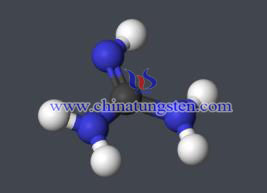High Efficiency Molybdenum Removal for Producing Ammonium Paratungstate––Guanidine-Salt-separation method
- Details
- Category: Tungsten Information
- Published on Monday, 01 February 2016 17:18
- Written by chunyan
- Hits: 268
 Guanidine-Salt -separation method, the method for producing ammonium paratungstate, which can effectively remove molybdenum and increase the crystallization rate of the product.
Guanidine-Salt -separation method, the method for producing ammonium paratungstate, which can effectively remove molybdenum and increase the crystallization rate of the product.
Steps:
1. Raw materials and catalyst, environmental selection;
Raw materials: industrial ammonium tungstate solution after removal of silicon; catalyst: silicon dioxide (SiO2) or silica; pH value at 7.0-8.0
2. Heating to precipitation and then filtrate the catalyst;
3. Adding carbamamidine or derivative of carbamamidine as a precipitating agent to precipitating tungsten (W) as a salt deposit (precipitation rate reaches 98% or more), and molybdenum (Mo) removed in the filtrate (the removal rate for molybdenum reaches 95% or more);
4. Filter and wash the precipitate with cold water for several times;
5. Adding precipitate to ammonia to form ammonium tungstate, while the precipitation agent exist sin a solid state;
6. Heating the ammonium tungstate to 80-100℃ to generate ammonium paratungstate crystal, the crystallization rate can reach 95%.
Noted: Controlling the pH value of precipitation in the process is very important, partly molybdenum will be precipitated when pH value is too low, thus reduce the effect of removing molybdenum; tungsten precipitation will be not completely when pH value is too high, and it will reduce the recovery rate of tungsten.
The advantages are as bellows: effectively remove molybdenum, crystallization rate of ammonium paratungstate can be increased by nearly 20% and reduce the cost, simplify the operation, compared with the traditional production process.
| APT Supplier: Chinatungsten Online ammonium-paratungstate.com | Tel.: 86 592 5129696; Fax: 86 592 5129797;Email:sales@chinatungsten.com |
| Tungsten News&Tungsten Prices, 3G Version: http://3g.chinatungsten.com | Molybdenum News & Molybdenum Price: http://news.molybdenum.com.cn |





 sales@chinatungsten.com
sales@chinatungsten.com